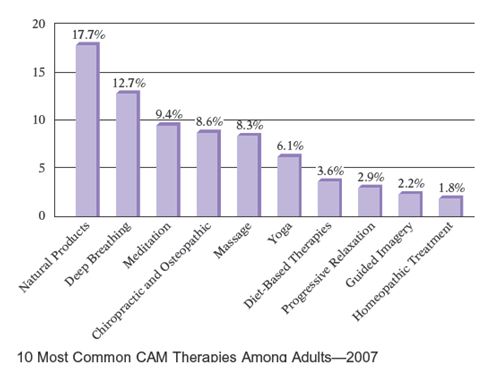Identify and briefly explain what is used to reach a clinical diagnosis of anemia
What will be an ideal response?
Answer: The clinical diagnosis of anemia requires a microscopic examination and analysis of red blood cells. A detailed medical history, including information on dietary habits, family history of anemia, and information regarding the patient's medical problems, provide data for the diagnosis.
You might also like to view...
Of all methods, _____ may be the most effective way to protect personal and public health from infectious diseases, such as the elimination of smallpox
A) antibiotics B) fomites C) nosocomials D) vaccinations
The statistics shown in the graph at the below are from the 2007 National Health Interview Survey (NHIS), an annual in person survey of Americans regarding their health-and illness-related experiences. The Complementary and Alternative Medicine (CAM)section gathered information on 23,393 adults aged 18 and older. In the United States, according to this survey, approximately 38% of adults are using some form of complementary and alternative medicine. If the adult population of the United States is approximately 208,000,000 people, how may adults are estimated to use some form of complementary and alternative medicine?

A) 59,040,000 adults
B) 99,040,000 adults
C) 79,040,000 adults
D) 69,040,000 adults
E) 89,040,000 adults
Which of the following statements regarding warm-ups and cool-downs is FALSE?
A. A minimum of 5 to 10 minutes should be devoted to cool-down. B. Suggested warm-up exercises include a low-intensity version of the exercise you are about to engage in. C. When you continue light activity for a cool-down, blood vessels gradually return to their normal smaller diameter. D. Taking a hot shower immediately after a main exercise program effectively aids in cool-down and blood flow return to the heart.
Which is the correct breakdown and translation of the medical term hydrarthrosis?
A. hydr (water) + arthr (joint) + osis (condition) = water in a joint B. hydr (water) + arthr (cartilage) + osis (condition) = water in the cartilage C. hydr (blood) + arthr (joint) + osis (condition) = blood in a joint D. hydr (blood) + arthr (cartilage) + osis (condition) = blood in the cartilage E. hydr (pus) + arthr (cartilage) + osis (condition) = pus in the cartilage